
views
Identifying Negative Thoughts

Practice mindfulness to observe your thoughts and feelings. Set aside 10 minutes every day to sit and observe this present moment. Note the thoughts and judgments that arise and let them pass on by. Breathe and allow yourself to feel your thoughts and your body. Be kind to yourself. Don’t judge yourself too harshly if your mind wanders; simply acknowledge that it has, and gently bring it back on track.
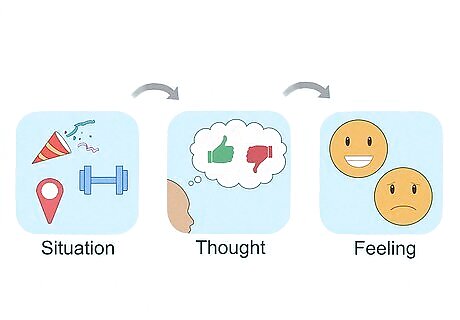
Examine the links between a situation, a thought, and a feeling. You may believe that a bad situation leads to negative feelings. The CBT approach challenges this by stating that it is the thoughts we have that lead us to have those emotions. A situation gives rise to a thought which in turn leads to a feeling or action. Here is an example of how a positive outcome is linked to thought: You went to the gym and exercised. You thought that you accomplished your fitness goal for the day. You felt satisfied and happy. Now here is an example of a negative outcome: You went to the gym and exercised. You thought that you didn't push yourself hard enough to meet your goal. You felt disappointed or not good enough.
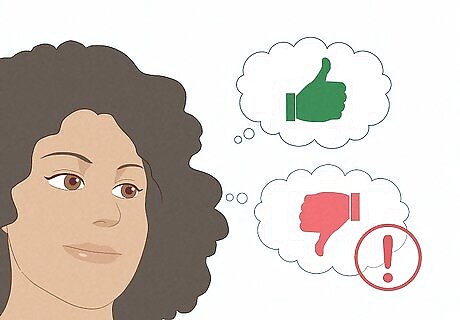
Recognize automatic thoughts. You have brief thoughts throughout the day that are triggered by a situation. You may not notice or pay attention to these thoughts, but with CBT it is important to have awareness of these quick thoughts. Pay specific attention to negative (or maladaptive) thoughts that you have when reflecting on a situation. Maladaptive automatic thoughts are distorted reflections on an event, but you may accept them as true. These maladaptive thoughts may then trigger feelings of sadness, anxiety, frustration, or hopelessness. Maladaptive: "I can't believe I got such a bad grade on this exam! I'm a failure, and I'll never amount to anything." This thought can lead to a spiral of negativity and hopelessness. Positive: "This is just one exam. Everyone does badly on an exam sometimes. I can continue to work hard at this to bring my grades up." You are more likely to be hopeful with this thought.
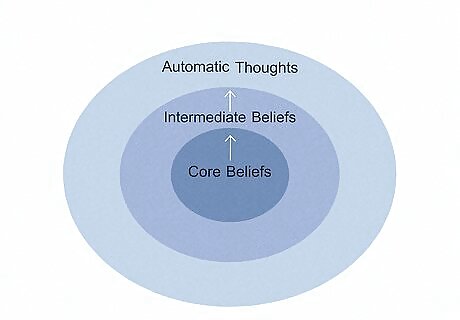
Link your automatic thoughts to your core beliefs. Underneath your automatic thoughts, you may have core beliefs that are distorted reflections of reality. These core beliefs are what drive these maladaptive thoughts. Thinking about how your core beliefs may be skewed towards negative thinking will help you to understand why maladaptive thoughts occur. Your core beliefs are related to your self-esteem or self-confidence. You may believe that you are unlovable or not good enough which leads to a pattern of obsessive behavior or continued feelings of anxiety or depression.
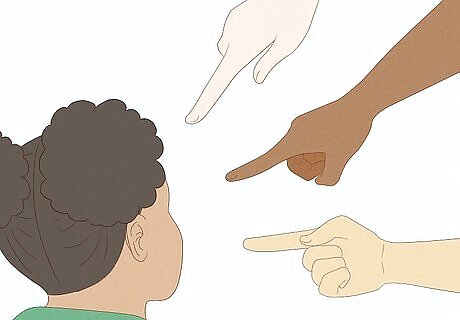
Consider the origin of your core beliefs. If your core beliefs are founded on a falsehood, then those beliefs themselves might not be true. Even if they are true, pondering where your fundamental beliefs come from can give you a stronger understanding of yourself. For example, many people get their core beliefs from the people they’re raised by. If your parents mistreated you, you might have a core belief that you’re not worthy of love. Separating your parents’ behavior towards you from your actual worth will show you that your core belief—that you’re unworthy of love—isn’t true at all.
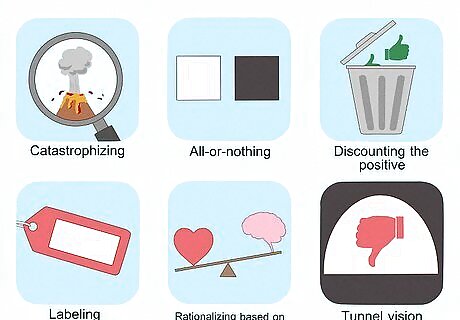
Identify cognitive distortions. There are many different ways that you may distort your thoughts which lead to negative emotions or behaviors. Notice the ways that you think or talk about a problem, and how you may be doing one or more of the following: Catastrophizing by predicting only negative outcomes in the future Having all-or-nothing thinking Discounting the positive Labeling something or someone without knowing more about it or them Rationalizing based on emotions rather than facts Minimizing or magnifying the situation Having "tunnel vision" by seeing only the negatives Mind reading in which you believe you know what someone is thinking Overgeneralizing by making an overall negative conclusion beyond the current situation Personalizing the situation as something specifically wrong with you

Download a CBT app for extra help. CBT apps offer a place to jot down your thoughts, set goals, and even challenge yourself with daily experiments. Use it as a tool to keep you on track and motivated. Search for “CBT app” in your app store to see what options you have. Wysa is an example of a CBT app that uses a chat bot to help you identify thinking errors and calm yourself with relaxation exercises.
Challenging Negative Thoughts
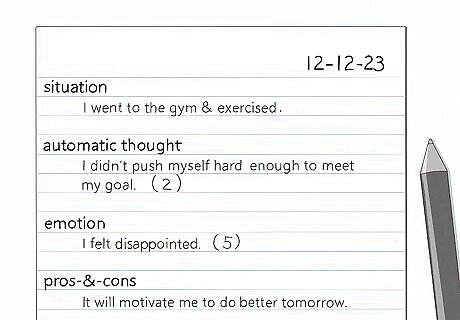
Create a thought record. By putting your thoughts in writing, you will be able to see your thoughts and emotions a little differently. The thought record should include a section about the situation, the automatic thought, and the emotion, and a separate section that reflects on the pros-and-cons, and another possible way to think about the situation. Your thought record should help to answer all these questions: What actually happened? Include where, what, when, and how. What thought went through your mind? Create rating scale of how much you believed it was true such as from 1-10 or 1-100. What emotion did you feel? Rate the intensity using a scale. What has happened to make you believe this thought is true? What has happened to disprove this thought? What is another way to look at this situation? How would you rate your mood after reviewing all these questions? Use a scale.

Develop balanced thinking. Just like when making an argument, your thinking may have pros and cons, or different ways of seeing the same thing. Think about the alternative ways of seeing a situation, or how to imagine a different approach or reaction to the situation. Open your mind up to other possible outcomes or ways of thinking. Identify alternative ways of thinking about a situation that are possible or believable to you. Consider asking someone you trust to identify different ways of thinking about the situation. Does that other person understand the problem or situation in a different or more positive way? Listen closely to those alternatives.

Identify pleasant activities. Think about something that you enjoy or enjoyed in the past, or something that you may want to accomplish but have not done yet. Consider activities that are possible or achievable possibly in the short term. Reimagine activities as small, doable goals. Consider scheduling one pleasant activity a day. It can be a different one each day, the same, or combination of a few. Make these activities small, but something that you can look forward to doing. If you used to play music in a band and want to be a musician again, think about activities to start with, such as playing music once a week at home. Set aside time when you can play with few distractions.

Take action and engage in those activities. Create an action plan. Consider writing down your goal, and then writing out your small steps. Think about the steps you need to take in the next week, month, or year, and create a timeline of how each step follows the next one. Look for alternative options or behaviors to accomplish a goal if there are barriers. For example, maybe a successful businesswoman becomes disabled after an accident, and can no longer work her previous job. She may decide that she wants to find a better line of work. She could teach business students at a local university, run business seminars, volunteer at a website like wikiHow, or be productive by offering advice and guidance to her family and friends.
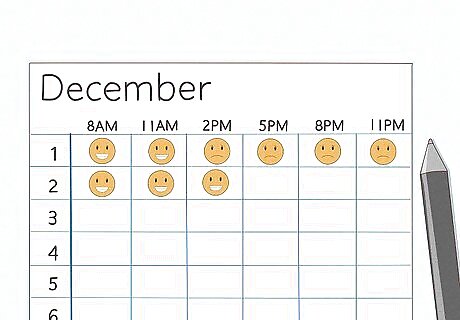
Monitor your mood at different times of the day. Use a daily calendar to monitor your emotions throughout the day. Consider making a "schedule for your emotions" by writing down what you are feeling every 3-4 hours. Look at any patterns that you see over time. Do you always feel bad at the beginning of the day and then by 12 noon you're feeling good? Think about any triggers between those times. Or vice versa, do you feel good in the morning before work, but by 2pm each day you're feeling miserable? Identify if there were specific things or events that occurred.
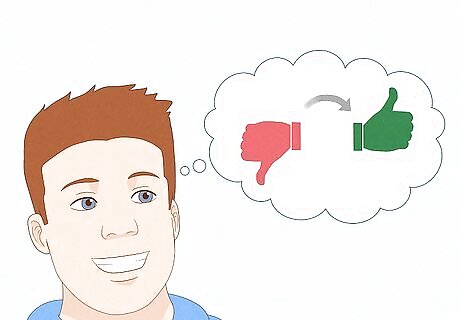
Replace negative thoughts with positive ones. Once you have learned to identify triggers that lead to negative thoughts and behaviors, you will be more self-aware about how to activate the brain. The moment you have a negative thought, use that moment to evaluate the truth behind that thought, and what may be a different way to approach it. Come up with positive and self-affirming statements that you can remember. Use these positive statements to guide you when your anxiety or depression is triggered. Use positive affirmations about yourself, your life, and the world around you. Identify positive things, even if they are small, that can help to train your brain to think positively.
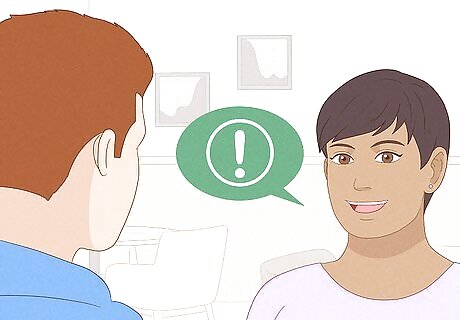
Work with an accountability partner for extra support. Ask a close friend, family member, or support group member to help you point out your negative thinking patterns, and offer to help them do the same. You’ll both get better at identifying negativity and recognizing your own patterns. Your partner might even point out some patterns you weren’t aware of.
Problem-Solving Your Primary Concern
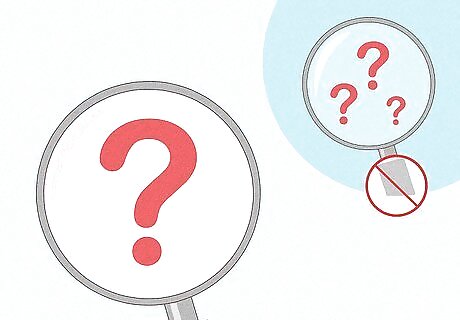
Focus on a specific problem you wish to solve. If there is a problem that you are trying to solve, use CBT techniques to help you focus your thoughts in a clear way. When you have a lot of different emotions and thoughts in your head at once, you may need to focus on only one problem at a time. Avoid attempting to solve multiple problems at once. Start small and focus on the one problem that is your primary concern. Focus on taking an active rather than a passive role when solving problems.
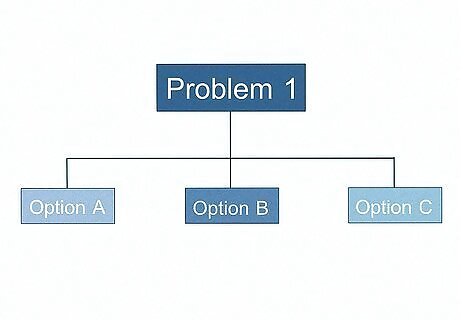
Open your mind to all options. Brainstorm all the possible options, whether they are bad, good, or neutral. Write down these various options. Even ideas that seem impossible at first may help to jumpstart you in the right direction. Think about solutions or advice you might give to someone else who is facing this same problem. Consider talking with a close friend or someone you trust for additional options.
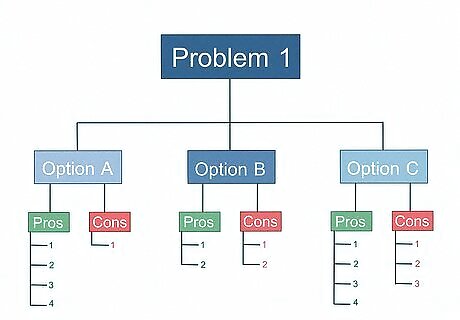
List the pros and cons of your options. Think about each option available to you, Stick with the most logical options first, then create pros and cons for each. Consider the pros and cons of the options that may seem very challenging last. This list will help you to see other options in a more balanced way. Make sure to look at both the positives and negatives, and not just one or the other. Consider whether you need advice from an expert or a professional for certain pros and cons, such as a financial advisor, lawyer, or healthcare professional.
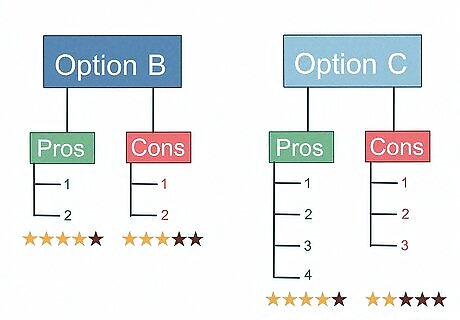
Rate these pros and cons. Examine how the pros and cons stack up relative to one another. Consider creating a rank order for your options. Talk with someone you trust about whether these rankings seem realistic. Ask them if they have any concerns about the plan you think is best.
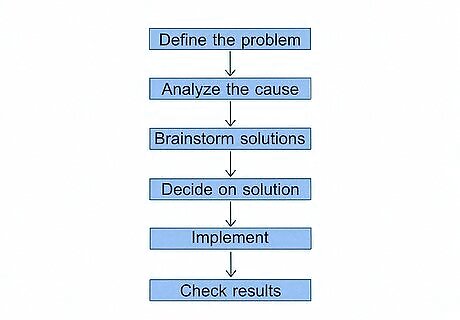
Take action on a specific plan to solve the problem. Find out the steps you need to take to enact the plan you have chosen. Your pros and cons list for the option you have chosen may help you to understand the steps you need to take and the ones to avoid. Create a timeline of small steps that you need to do. With organization and planning you are more likely to carry out and achieve your goals.
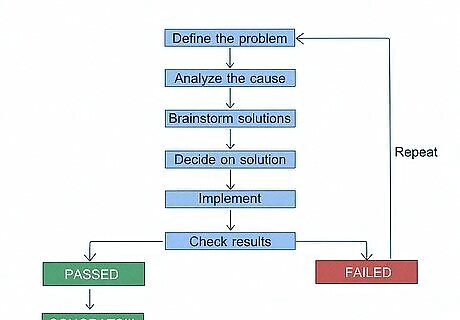
Review the outcome of this plan. Avoid being easily deterred if your plan does not go the way you wanted. Go back to the planning phases of problem solving and figure out what missteps may have been made or not addressed. If the plan led to a positive outcome, enjoy that moment. Even if the problem is not fully "solved," be thankful that you are headed in the right direction. If the plan still needs some tweaking and negative thoughts still arise, keep going and stay motivated. Most negative thoughts, feelings, and situations don't go away overnight, but that doesn't mean they are impossible to work on.

Celebrate success. Reward yourself with an activity that you really enjoy. Let yourself fully feel the satisfaction of making progress, no matter how small it is. Rewarding yourself will keep you motivated and feeling positive as you continue to take steps forward. Go out for dinner. Have a spa night (even if it just involves a bubble bath and some nice music). Set aside a block of time for things you enjoy. Spend time with a loved one. Put your feet up and watch a movie.
Using Relaxation Techniques

Try deep breathing. Breathing exercise can help you to cope with stressors, triggers, and automatic negative thoughts. While relaxation techniques may not "get rid of the problem," it is important to learn how to focus your mind and energy constructively to avoid anxious or obsessive thoughts. Consider this abdominal breathing technique: Place one hand on your chest and the other on your abdomen. Exhale with your mouth, and take a slow deep breath in with your nose. Inhale as deeply as you can and hold for 7 seconds. Slowly exhale through your mouth for 8 seconds. As you release the air with relaxation, contract gently your abdomen to remove the remaining air from your lungs. Repeat this cycle for a total of 5 deep breaths. Try to have rate of one breath every 10 seconds. This helps both your heart rate and your mind.
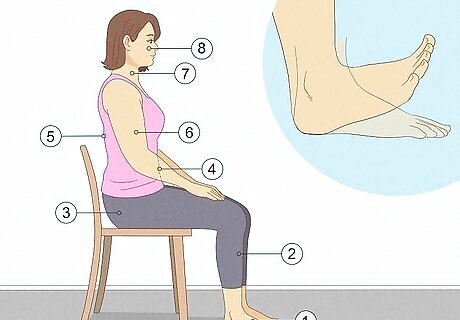
Use progressive muscle relaxation exercises. This is another relaxation technique that starts with deep breathing, but focuses your mind on how to release muscle tensions the body. This can help relieve anxiety. It can be done with the guidance of a mental health or holistic health professional. Focus on deep breaths, and notice your breathing. Focus on tensing and releasing muscles in the body for five seconds each. Focus your mind on your body parts, starting with the feet. The progression is feet, legs, pelvis, stomach, back, arms, neck, and face.

Engage in guided imagery or other visualization techniques. These techniques can help you redirect your negative thoughts or stressors to something peaceful and safe. They can help you when triggers for maladaptive thoughts occur. You can also do these at night before bed. Your peaceful place can be somewhere you have been before, or possibly dreamed about. Visualize this way: Close your eyes, and imagine a peaceful or happy place Notice the colors, shapes, movement, light and textures of this place Listen to sounds around you that emerge Notice smells in this place Focus on any sensations of touch such as the floor or earth beneath you, the temperature, or anything you can touch.
Finding Professional Help
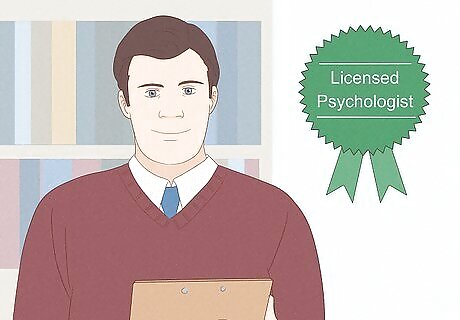
Find a trained mental health professional with expertise in CBT. There are many professionals who are trained in specialized forms of CBT such as Trauma-focused Cognitive Behavioral Therapy, Problem-Solving Therapy, and Acceptance and Commitment Therapy. Contact a counseling center or private practice therapist in your local community and find out about their experience with CBT. When looking for a mental health professional, consider these: Licensed professional counselors Licensed clinical social workers Licensed psychologists Licensed Marriage and Family Therapists Certified addiction counselors

Find providers through your health insurance. Most health insurance plans have behavioral health as part of your (or your family's) medical coverage. Consult your insurance company about local providers. Find out if the mental health professionals covered under your insurance are specialized in CBT. Consider consulting with your primary care doctor for possible referrals for a trained mental health specialist. If you need a medication consultation, request a referral for a psychiatrist or mental health nurse practitioner.

Talk with a counselor at your school or through an employee assistance program. There may be low or no-cost options through your school if you are a student. Also, many employers have employee assistance programs to help employees who are going through difficult transitions. Find out if there may be options to go to a counseling center through your school. Ask if there are counselors who specialize in CBT. Identify if your employer has an employee assistance program. Contact the number available. The information discussed through the employee assistance program is confidential. It may be free of charge for the first few counseling sessions.

Utilize crisis support services for help. There are crisis hotlines available if you are in immediate crisis. There are also hotlines to find places for treatment and local resources in your area. Consider these options if there is an urgent need: Suicide and Crisis Lifeline (available 24/7): 988 or https://988lifeline.org/ SAMHSA Treatment Referral Helpline to find local treatment centers: 1‑877‑SAMHSA7 (1‑877‑726‑4727) or https://www.samhsa.gov/find-help/national-helpline


















Comments
0 comment